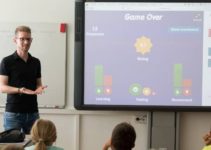What is your teaching strategy in the new normal? For fellow educators, here are 5 teaching strategies in the new normal that I tried and worked. I include a sample instructional module for teachers’ reference.
Table of Contents
Background
Teaching in the new normal brings with it challenges that appear almost insurmountable. Although school administrators intermittently issue memos to shift from all online school activities to face-to-face sessions, there are still apprehensions whenever symptoms or indications of COVID-19 infections appear. There is stigma associated with someone getting sick: has fever, with cough and colds, diarrhea, among others.
Nowadays could not be categorically declared a post-COVID-19 scenario given the various mutations of the coronavirus. The immunity imparted by vaccines against early virus strains is not a guaranteed immunity to oncoming virus strains.
Hence, while there may be successes attained by the government’s vaccination program, the population is not assured of absolute protection to keep themselves healthy and able to cope up with the severe, sometimes fatal, effects of COVID-19 infection.
Vaccine experts believe that booster shots are necessary to sustain virus immunity established by earlier vaccine doses. The efficacy of these added doses, however, is still subject to scrutiny. The side effects of extra doses may manifest in the near future or in the long-term.
It is this uncertainty, and the great risk imposed by the coronavirus, that the rational choice in these trying times is to keep on engaging in online teaching and learning. But are the teachers ready to face the challenges of teaching in the new normal?
Many teachers, particularly the non-technologically inclined, find the online learning mode too much for them. The situation is ironic, because teachers who need to stay at home because of comorbidity concerns are also the ones who are technologically challenged.
Teaching Strategies in the New Normal
1. Prepare learning materials beforehand
As early as 2009, I started writing online, primarily as a hobby. I know very little of how the web works. But then, with patience, I could create my website (amazingly, it’s still there!) using drag-and-drop technology offered by webnode, a Czech company. Thus, I have a free hand on what I would include on that website.
I integrated my teaching materials in my writing activity, thinking that the articles I wrote would be helpful to students in the future. It would then also be easier to link, as those materials are already online. Students can open those articles in the convenience of their homes.
This approach brought in dividends, because those instructional materials served as the basis for the instructional modules that I have created since COVID-19 forced everyone to adopt the virtual learning mode. It must be a matter of foresight and luck, because the disruptive nature of the internet would be the norm in the future. And it did as we gradually transition to the Education 4.0 learning approach spurred by the fourth industrial revolution, otherwise known as Industry 4.0.
After more than a decade of online activity, I can say that I have learned more than enough to keep up with recent advancements in online learning. I came up with my Blended Website Learning Model, that I believe is the best way online learning can be delivered amid the struggle of poor internet connection in many parts of the world.

If you are a teacher or a mentor and have written nothing online, it will not be too late to do so. It would be easier to link to what you have already written as instructional material before if it’s online. And you can just update these instructional materials every school year or semester.
Your students will truly appreciate your work, which contains curated references, videos, and other great resources that facilitate learning online. Most likely, as a teacher, you will be in the best position to write something about your topic.
That’s my conclusion after seeing that many of the educational articles I posted online have been read by thousands of readers daily. Some of them come up to the top of keyword searches and ranked no. 1.
In fact, the article I wrote on conceptual framework garnered so many views and stayed at the top of the searches for several years. I wrote this article in 2015 because I could not find any relevant material about the topic which my students badly need. They always struggle on this part of the thesis writing process.
Now, I can see many other articles on the same topic that drew information from that article. Some even made it on the top of the searches using exactly the steps I outlined.
I don’t know if that would mean flattery or plain plagiarism of my original composition. Anyhow, that article was cited 153 times at this writing by researchers in Google Scholar. It had become an authority on the topic.
Also, integrating related articles I wrote since 2012 also helped me come up with books and e-books that helped finance this writing site and keep it online for almost a decade. Simplyeducate.me will turn 10 years in the next four days.
2. Create or use curated videos
You can find virtually almost all the instructional materials you need on YouTube. YouTube is a video sharing service where any teacher can upload his or her instructional materials just like anyone. It also has the potential to earn through the ads displayed along with the video. As a teacher struggling to make ends meet, plus the additional cost of being online, any potential earning will be most welcome.
If you have no time or find difficulty in creating your own instructional videos, you can curate existing videos. Find one that’s applicable to your teaching needs and link to it or embed the video if possible. You need to curate because the instructional videos may not satisfy your quality standards.
Here is a reference on how to embed a video in WordPress, a popular web development software: How to Embed Video in WordPress.
It takes time to create an educational YouTube video with captions. But that time is well spent, as it can be both educational and entertaining at the same time. I composed one for the first time (see video below).
3. Develop short instructional modules
Synchronous sessions or real-time online sessions with students need not take most of your teaching time, as other teachers mistakenly do. That will surely exhaust not only your students but yourself.
Short, direct to the point instructional modules, take care of the course content that your students need to understand their lessons. Having studied a course in Coursera, I appreciate the way the instructional modules are structured.
The whole course outline goes this way:
- Module Overview
- Learning Objectives
- Readings
- Lectures
- Study Questions
- Assignment
- Quiz
The instructional video in that course is short; usually about five minutes at the most. But in the instructional modules I prepare for my class, I embed curated videos that can last 30 minutes. It all depends on your judgement as a teacher.
One thing to note, however, is to always update the links and the videos that you include in your instructional material every year or semester. Chances are, those links are obsolete or have been changed or updated by the creator.
That’s what I just did in the example instructional module that I include in this article for your reference and as a service to the teaching community where I belong. I describe the module and provide a link to the free PDF version of the instructional module below.
Sample Instructional Module on Biogeochemical Cycles
The purpose of this module is to enable students to diagram the essential biogeochemical cycles and explain how the important elements of life, namely hydrogen, nitrogen, oxygen, carbon, phosphorus, and sulfur, are cycled in the biosphere. The information provided in this module will enable the students to trace the different elements in various forms and how man can disrupt the natural processes of the biogeochemical cycles.
J. P. A. Regoniel, PhD
4. Monitor student outputs using a matrix
It is good practice to monitor student performance and let them know you monitor their performance. This teaching strategy not only helps you assess the performance of the students but also encourages them to keep up with the lessons.
According to Dr. Shali Tarot, highlighting the accomplishments of other people is a really strong incentive. Thus, if some students accomplish the tasks they are supposed to do and keep with the deadlines, the others follow suit.
I use a matrix showing the submissions made by students, which everyone can see each time I meet them. I also show the matrix of accomplishments on the password protected website I created for my instructional materials.
You can just put a star, a thumbs up, or any encouraging symbol to mark a student’s accomplishment. I show an example matrix of the way I do it below.
| Student Name | Module 1 | Module 2 | Module 3 | Module 4 | Module 5 | Module 6 | Module 7 |
| John Dela Cruz | 👍 | 👍 | 👍 | ||||
| Abegail Guanzon | 👍 | 👍 |
Seeing the performance of others prompts them to do better or keep up with the expected outputs.
5. Always record and upload synchronous sessions
Although there are many reasons for students’ inability to attend a synchronous session, such as poor internet connectivity, work demand or personal issues, recording each session and making them available online wards off excuses. Creating a simple, fast loading website allows students to review the past discussions during their free time and helps them keep up with the lessons.
Recording synchronous sessions using the free services of Zoom or similar app is easy. You need not record a long discussion. A 30-minute session is ample time to explain the purpose of the next instructional module to accomplish. You can also give feedback on the submissions or check on the circumstances of the students.
Conclusion
The teaching strategies like the 5 enumerated here, namely 1) prepare instructional materials ahead of time, 2) create or use curated videos, 3) develop short instructional modules, 4) monitor students output using a matrix, and 5) always record and upload synchronous sessions arose out of the necessity of conducting classes online. Applying them can help ease your difficulty in teaching online and make the most of online tools to carry out your task as a teacher or mentor.
As a teacher in the new normal, you need to develop the following skills to apply the teaching strategies outlined in this article:
- Write articles online using free and easy to use writing platforms like WordPress or Webnode,
- Create videos using your android phone, free windows video editor integrated with your PC or Mac video editing software Apple iMovie, among others,
- Develop nice-looking instructional modules like mine using Lyx, an open-source document processor.
Remember, it is never late to learn something new.
Learning never exhausts the mind.
Leonardo da Vinci
©2022 October 16 J. P. A. Regoniel


